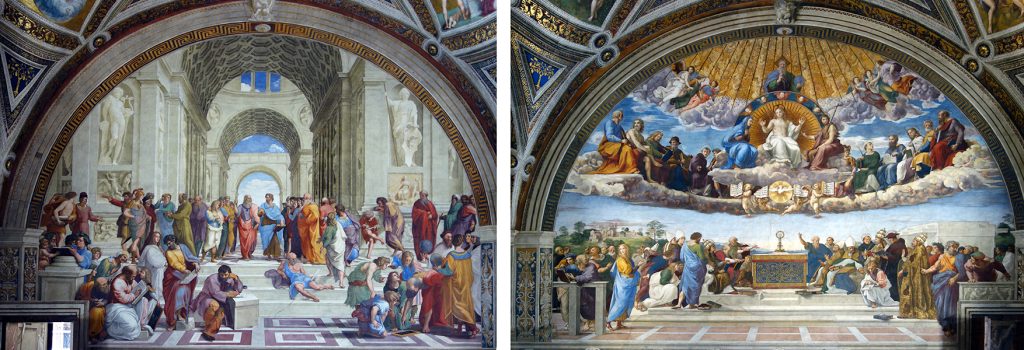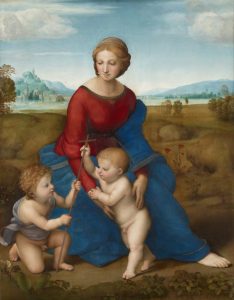Raphael, an introduction
Raffaello Sanzio, better known simply as Raphael, enjoyed a meteoric career. An impeccable professional artist and a consummate courtier, Raphael was famed both for his artistic skill and his charismatic personality. From his beginnings as a local painter in his native Marche and later Florence, Raphael skyrocketed to fame in Rome, ultimately becoming the city’s most sought-after artist. Raphael’s untimely death at the age of 37 (in 1520) while at the height of his visual powers only solidified the legend of his extraordinary talent.
His visual accomplishments range from paintings of all sizes and drawings in chalk and ink—some intended to be translated to print—to elaborate fresco cycles, tapestry designs, and architecture. He was shrewd and meticulous, and his work is notable for its elegance and poise, for the ease with which he translated nature into idealized artifice. How does one paint divine grace or the very concept of philosophy? Raphael did such things with apparent ease. He embodied the ideal of sprezzatura (the appearance of nonchalant effortlessness in his creative process), a notion popularized by Raphael’s good friend, Baldassare Castiglione, in his Book of the Courtier (1528).
Early career
Raphael was born in Urbino into the circle of one of the most sophisticated and intellectually oriented courts in Italy. Following the tradition of family craft, Raphael was initially trained by his father, Giovanni Sanzio, who was court painter to the ruling Montefeltro family and ran a thriving workshop. Vasari tells us that Raphael was sent by his father to continue his training under Pietro Perugino, presumably because the precocious youth had learned all he could at home. Perugino was a leading artist in both Florence and his native Perugia and his influence on Raphael’s early paintings is unmistakable.
Raphael in Rome
Having never completed a large-scale project in Florence, Raphael left for Rome in 1508. He was drawn to the Eternal City by the powerful Warrior Pope, Julius II who was in the process of re-vitalizing Rome. Julius was an astute patron. He recognized the potential of art and architecture to give material form to his vision for Rome as a new center of the Christian empire—one that would rival antiquity.

Raphael was initially one of a number of artists hired by Julius to decorate his personal suite of rooms in the Vatican palace, a semi-public space where the pope’s interests were to be materialized in art.
Raphael’s success in the papal suites lead to a flourishing Roman career informed by all he saw there. He studied with equal attentiveness the art and architecture of antiquity and the Roman work of his contemporaries, including Michelangelo, who was working on the Sistine Chapel ceiling while Raphael was undertaking the frescoes in the papal suites. Raphael worked for merchants and bankers, for popes and mighty statesmen.

Working method
Raphael worked well with others. He ran a large and complex workshop comprised of skilled collaborators who enabled him to realize numerous projects simultaneously. A shrewd manager and skilled teacher, Raphael provided highly detailed preliminary drawings for projects that could then be realized by his extensive and trusted workshop all under his meticulous eye. Raphael knew how to delegate to his team, capitalizing upon the strengths of those who worked for him.[1]
Madonna of the Meadow
Raphael spent the four years from 1504 to 1508 in Florence. There, still in his early 20s, he discovered that the painting style he had learned so painstakingly from Perugino was already outmoded. Florentine crowds flocked to the church of Santissima Annunziata to see Leonardo’s recently unveiled cartoon of the Virgin, Christ Child, Saint Anne, and Saint John. Under Leonardo’s influence, Raphael began to modify the Madonna compositions he had employed in Umbria.

In Madonna of the Meadow, Raphael adopted Leonardo’s pyramidal composition and modeling of faces and figures in subtle chiaroscuro. Yet the Umbrian artist placed the large, substantial figures in a Peruginesque landscape, with his former master’s typical feathery trees in the middle ground. Although Raphael experimented with Leonardo’s dusky modeling, he tended to return to Perugino’s lighter tonalities and blue skies. Raphael preferred clarity to obscurity, not fascinated, as Leonardo was, with mystery. Raphael quickly achieved fame for his Madonnas, which depict Mary as a beautiful young mother tenderly interacting with her young son. In Madonna of the Meadow, Mary almost wistfully watches Jesus play with John the Baptist’s cross-shaped staff, as if she has a premonition of how her son will die.[2]

